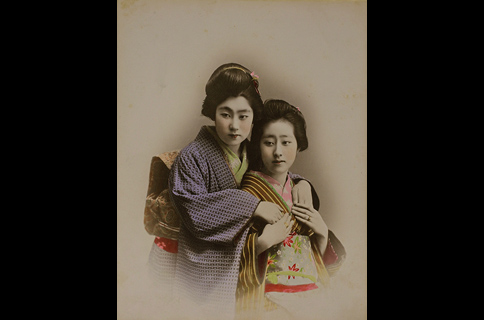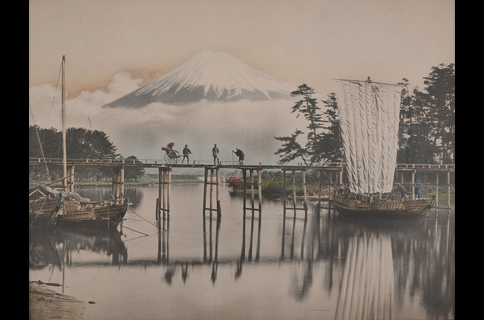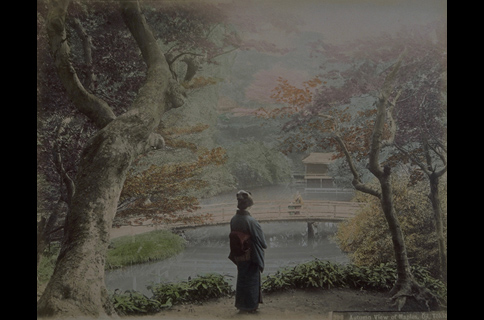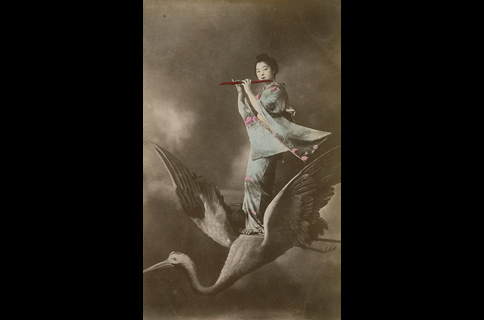- Home
- Exhibitions & Events
- The Story of Seibei Kajima, the “Millionaire Photographer” in the Meiji Period
Fujifilm Square Photo History Museum Exhibition
The Story of Seibei Kajima, the “Millionaire Photographer” in the Meiji Period
From June 1 to August 31, 2019, the Photo History Museum at Fujifilm Square will mount an exhibition of works by the photographer Seibei Kajima, who was active in the Meiji period (1868—1912). The exhibition is the first in Japan to introduce the career and achievements of Kajima, the “Millionaire Photographer,” who contributed much to the world of photography in Japan.
Seibei Kajima came from an affluent background, which allowed him to invest his assets and half a lifetime in photography in the mid-Meiji period. He was eighth in the line of proprietors of Kajimaya, the foremost sake wholesaler in Japan located at Reiganjima Shinkawa in Tokyo (presently, Shinkawa, Chuo-ku). A wealthy merchant house, Kajimaya was on a par with the then leading department stores of Echigoya, Daimaru, and Shirokiya. The chance discovery in a warehouse of a camera that had belonged to one of his predecessors inspired Kajima to immerse himself in photography. In the space of a few years, he made his name by financing the Tsukiji Kanpan Seizojo (Tsukiji Dry Plate Manufacturing Company), the Nihon Shashinkai (Japan Photographic Society), and the Dai Nihon Shashin Hinpyokai (Greater Japan Photography Critique Society). He also opened the extravagant Genrokukan photographic studio, which was equipped with a revolving stage and arc lights.
In the 1880s and 1890s, he became known as the “Millionaire Photographer” because he tried his hand at unprecedented forms of photo production, using custom-made large-format cameras to take oversized photographs or X-ray photographs, and magnesium flash to take photographs at night. Kajima's contributions to the development of photography in Japan were significant, but it was his exceptional largesse that was the talk of the town at the time.
In 1890, Kajima asked Ponta, then an apprentice geisha at Tamanoya in Shinbashi, to pose for his posters, a coincidence that led to them spending their later lives together. In 1896, his lavish spending habits caused relations with the Kajima family to break down. He spent the remainder of his life with Ponta who supported him through his dramatic final years when he had to close the photographic studio and lost a finger in an explosion.
Focusing on Kajima's appeal, the exhibition brings together a range of his work including Mt. Fuji (reproduction), a masterpiece that was presented to the Imperial Household, a stage photograph (reproduction) of Ichikawa Danjuro IX in Shibaraku, one of the Kabuki Juhachiban (Eighteen Famous Kabuki Plays), the glamorous figures of Ponta, the talented geisha, and Oen, the mistress of Kajima's younger brother Seizaburo, and applied arts photography printed on silk screen. We hope you will enjoy this glimpse of the magnificent world of Seibei Kajima, not a mere hobby photographer but someone whose accomplishments contributed in significant ways to the world of photography in Japan.
Profile
Seibei Kajima (1866—1924)
Seibei Kajima's given name at birth was Masanosuke. He was the second son of Seiemon Kajima who was the proprietor of the Kajimaya sake wholesaler in Osaka. When Masanosuke married Nobu, the daughter and heiress to the Kajimaya flagship store in Shinkawa, Tokyo (presently, Shinkawa, Chuo-ku), he took the name Seibei Kajima VIII. In 1885, Kajima was learning photography from Shojiro Imatsu, a photographer based in Asakusa who attended the Kajima household every other day to give lessons. In 1888, Kajima set up the Tsukiji Kanpan Seizojo (Tsukiji Dry Plate Manufacturing Company) together with Kazumasa Ogawa and William K. Burton. The following year, he joined the newly established Nihon Shashinkai (Japan Photographic Society) as a member. When the Dai Nihon Shashin Hinpyokai (Greater Japan Photography Critique Society) was formed in 1893, Kajima was appointed its vice-president. In 1895, he opened the Genrokukan photo studio in Kobikicho, Ginza, where he also built an adjacent exhibition hall for fine arts. The studio was managed by his younger brother Seizaburo. In the same year, Kajima joined with Count Ujitaka Toda to set up the Nihon Gentokai (Magic Lantern Society of Japan). In 1896, he successfully demonstrated X-ray photography at the Greater Japan Photography Critique Society. The following year, he photographed the funeral cortege of the Empress Dowager Eisho using magnesium flash to produce the first outdoor night photography in Japan. After relations with the Kajima family broke down, he closed the Genrokukan studio. He bought out Ponta's contract with the geisha house and opened a photo studio in Kyoto, but the venture failed. Several years later, he opened the Harukikan photo studio near the Hongo-za Theater in Tokyo. One day, when handling magnesium he had an accident that severed his right thumb. As a result, he closed the photographic studio and joined the Morita school of Noh flute under the name of Kisaragi Miki. Seibei Kajima died of illness at age 58.
| Title | Fujifilm Square Photo History Museum Exhibition The Story of Seibei Kajima, the “Millionaire Photographer” in the Meiji Period |
|---|---|
| Period | June 1 — August 31, 2019 Open every day from 10:00 to 19:00 (last admission 18:50) |
| Number of works | Approx. 25 works |
| Venue | The Photo History Museum at FUJIFILM SQUARE (Tokyo Midtown West) |
| Admission | Free |
| Organized by | FUJIFILM Corporation |
| Exhibition curator | Naomi Izakura (Photo historian) |
| In cooperation with | Japan Camera Industry Institute |
| Planning by | Photo Classic |
<Events during the exhibition>
Gallery talk by Naomi Izakura, photo historian and exhibition curator, on the life and work of Seibei Kajima, the “Millionaire Photographer”
| Date | Sat. June 29th, 2019 14:00—14:30 /16:00—16:30 Sat. July 20th, 2019 14:00—14:30 /16:00—16:30 Sat. August 10th, 2019 14:00—14:30 /16:00—16:30 |
|---|---|
| Venue | The Photo History Museum at FUJIFILM SQUARE |
| Admission | Free * No registration required * No seats available |

- In 1991, the Association for Corporate Support of the Arts founded these awards, which recognize highly beneficial projects by corporations and corporate foundations for the support of the arts, with the aim of encouraging corporate patronage of artistic projects and increasing public interest in these activities.
- The awardees are decided on the basis of an evaluation that covers the company's ingenuity and making use of its managerial resources, the involvement of the company in the arts, culture and the wider community, the company's attitude to continuing and expanding the activities, and the activities' degree of importance in contributing to the arts and wider culture.
- This year's awards, entitled “This is MECENAT 2018”, attracted 152 entrants. A town of third-party experts selected a total of seven awards, namely, the Grand Mécénat Award, five Awards for excellence and the Award Granted by the Commissioner for Cultural Affairs.







